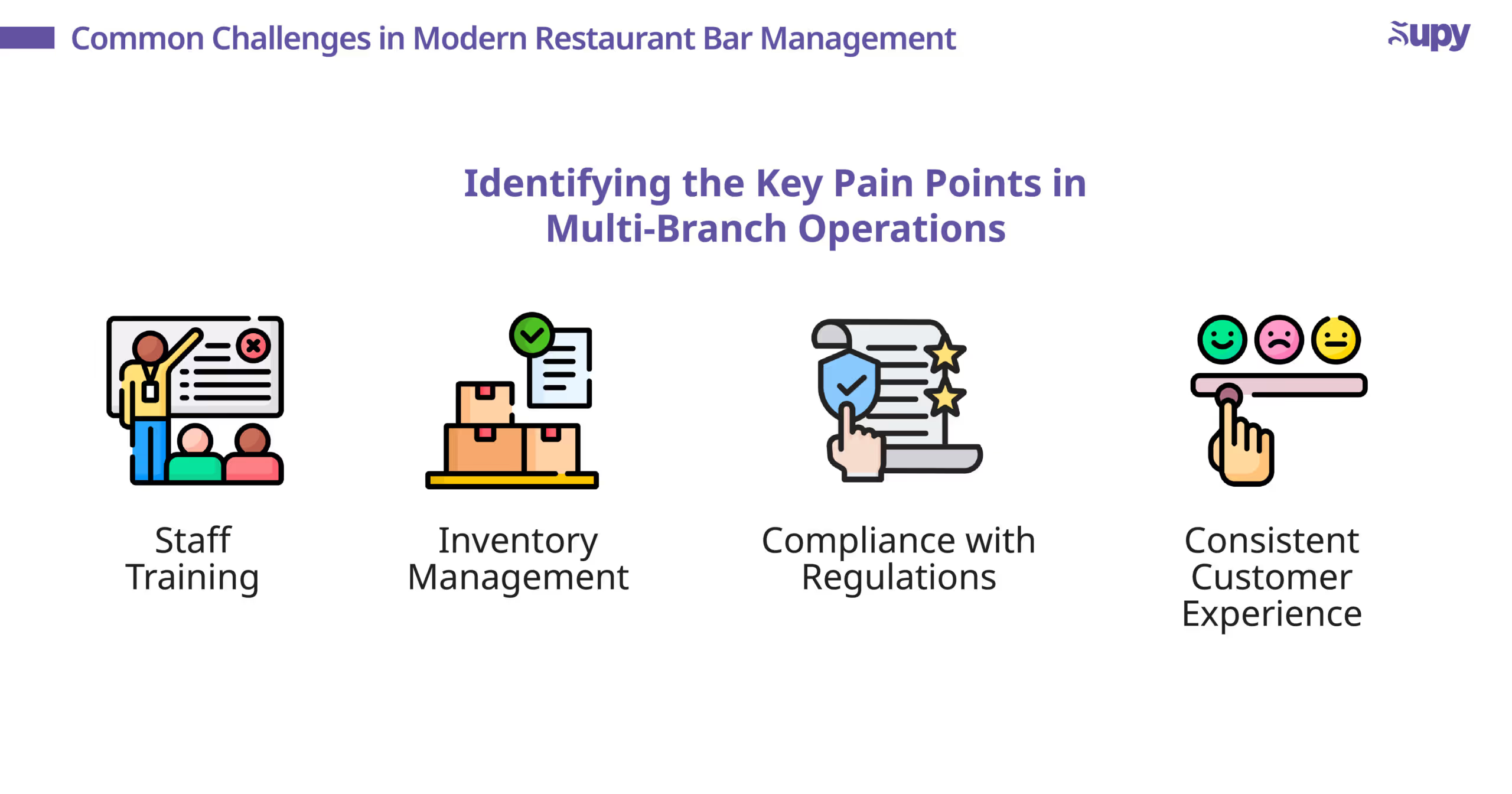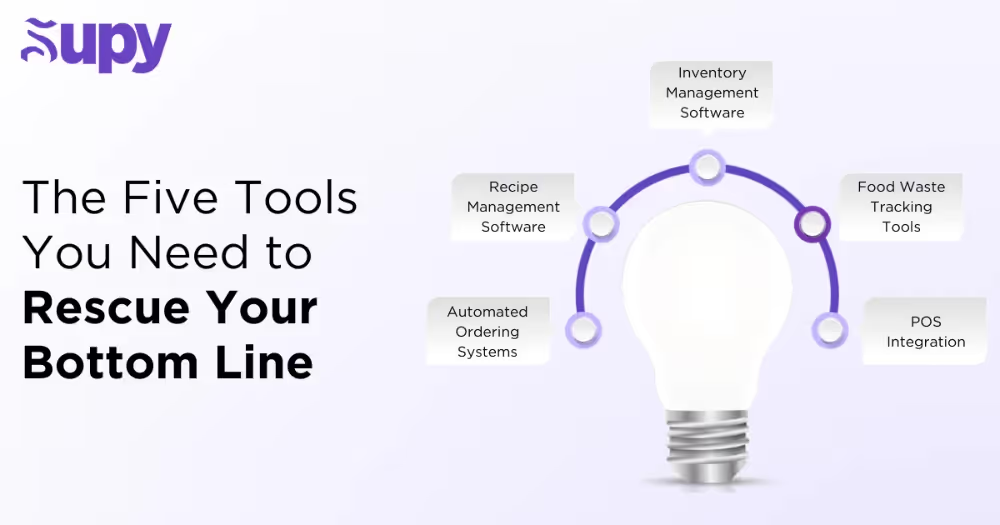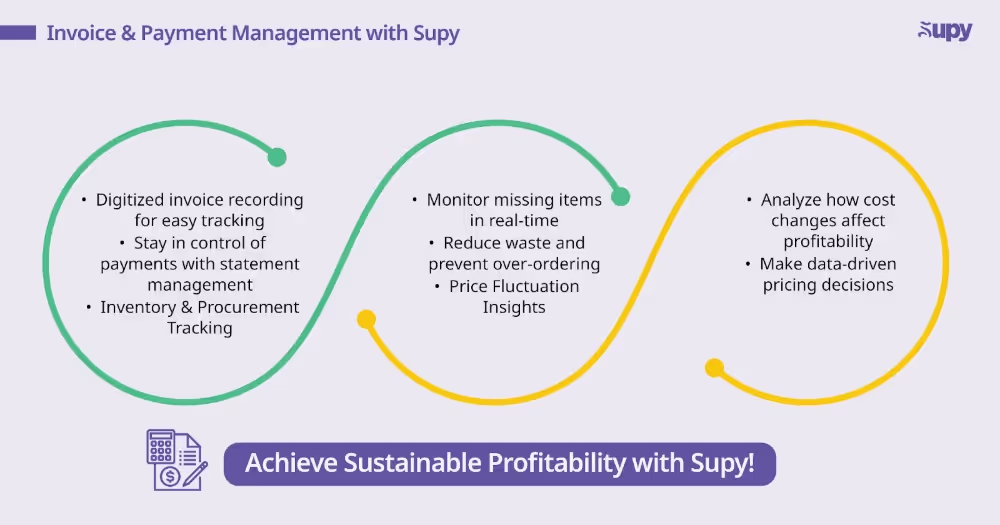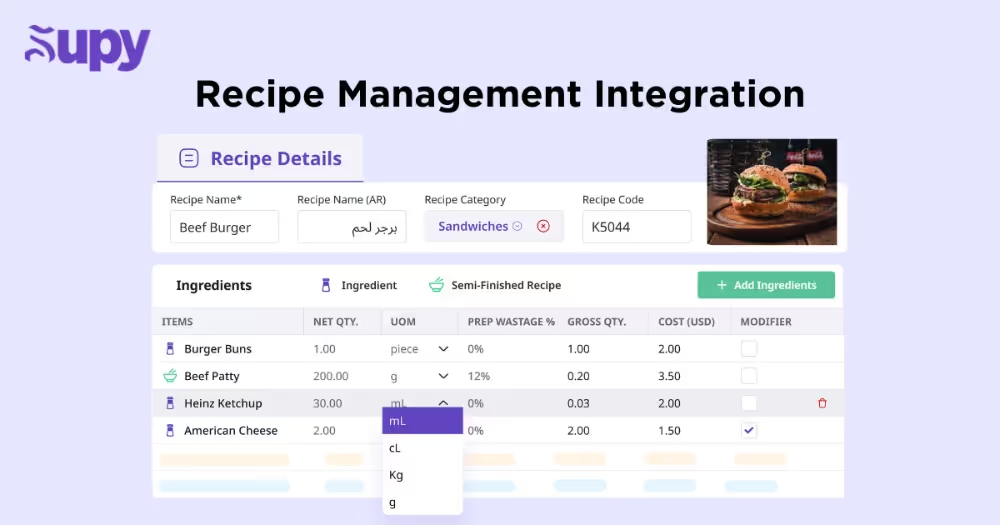How to Navigate the Challenges of Bar Management in Large Chains

Congratulations! You’ve successfully expanded your restaurant business across multiple locations!
Now it’s time for the real challenge: keeping this ship afloat! Managing large restaurant bar chains is a notorious task that comes with its own distinct set of challenges. According to the National Restaurant Association, 2024 restaurant and bar sales are forecast to top $1 trillion for the first time in history! With the economy thus recovering, our work sure isn’t over yet!
Consider the case of one successful chain with 15 bars spread out across the region. The business found itself initially struggling with inconsistent drink quality across its locations as well as high inventory costs. Yet by implementing a centralized training program and advanced inventory management software, the business soon managed to streamline its operations to a uniform standard. This had the happy consequence of not only improving rates of overall customer satisfaction but also cutting down on costs and waste!
Table of Contents
- Understanding Common Challenges in Modern Restaurant and Bar Management
- How to Overcome Common Restaurant Bar Management Challenges.
- Case Studies of Successful Implementations.
- Supy's Role in Navigating Common Restaurant Bar Management Challenges.
- Conclusion.
- About Supy.
For restaurant owners and managers dealing with similar issues as the bar chain mentioned above, it’s important to understand and address these challenges. Whether you’re trying to optimize bar staff scheduling, ensure adherence to safety standards, or integrate new technologies to streamline your processes, having a clear strategy can make all the difference.
1. Understanding Common Challenges in Modern Restaurant and Bar Management

Managing multi-branch bar locations is a complex and time-consuming task. Many bar owners, managers, and hospitality professionals often face several hurdles in their path to success, some of which have been listed below:
Staff Training
High employee turnover rates in bars and restaurants have often been cited as a significant challenge in the restaurant industry. Often, staff view these jobs as a mere stepping stone to more “gainful” employment, rarely looking at them as long-term career opportunities. Consequently, they tend to move on quickly, leaving the establishment scrambling for replacements.
For this reason, it can be hard to ensure that every team member across your multiple bar chains is consistently trained in customer service, cocktail preparation, and bar management practices. Without standardized training protocols, the quality of service can vary, leading to inconsistent customer experiences and a potential loss of business.
Inventory Management
Bar inventory management can pose a significant challenge for bars and restaurants. Unlike single-location bars, large chains must manage inventory across multiple sites, making it difficult to monitor the entire process, from stock levels to waste. Misjudging the quantities of perishables to stock could lead to an abundance of waste if the goods are not consumed before going bad or missed sales opportunities if you run out.
Compliance with Regulations
Maintaining compliance with food safety regulations, liquor laws, and various other standards is yet another challenge of restaurant management. Large chains must navigate complex legal requirements, including alcohol licensing, health and safety standards, and local regulations that may vary from one location to another. Non-compliance can lead to severe consequences, such as hefty fines or closure of your establishment. Operational oversights in these areas aren’t just dangerous to your customers’ health but could irreparably damage your reputation.
Consistent Customer Experience
It should come as no surprise that a restaurant bar’s success largely hinges on customer satisfaction. As such, any slip in service or food quality can be detrimental as it risks alienating patrons who could take their business elsewhere.
Managing customer satisfaction entails more than just serving good food and drinks, however. Staff should be trained to provide excellent, consistent service—be attentive to each guest’s needs and make them feel appreciated.
2. How to Overcome Common Restaurant Bar Management Challenges

Although managing a large bar chain comes with a unique set of challenges, with the right strategies, these obstacles can be easily circumvented. Here are our top tips on getting started:
Staff Training
A viable solution for high staff turnover rates lies in effective recruitment and retention strategies. To recruit the right staff members, it's important to:
Clearly define the roles and responsibilities of each position and craft a compelling job description. This will attract candidates who are a good fit for the restaurant's culture and values.
Once the staff members are recruited, it's important to provide proper training and development opportunities to ensure they have the skills and knowledge to excel in their roles. Offering competitive salaries, benefits, and a positive work environment can also help in retaining talented staff members and increasing rates of employee satisfaction.
Moreover, offer clear paths for progression within your establishment to make employees see the potential of developing a career rather than simply filling a temporary position. That way, you may be able to transform seemingly temporary positions into fulfilling careers that employees are less likely to leave hastily.
Inventory Management
A practical solution to this issue is implementing robust inventory control systems (like Supy’s POS system!). Such tools can help you track your liquor inventory, how quickly certain items are being sold, and remind you when you need to reorder.
Furthermore, consider regular stock checks at stipulated intervals in order to identify any variances in your bar business. This will help maintain a balanced stock that meets your customers’ demands without resulting in surplus waste or lost bar profit margins due to theft. Make regular audits and real-time monitoring a part of your routine to further optimize inventory control.
Compliance with Regulations
Compliance with local regulations, including health and safety standards, is essential to avoid legal issues. Large bar chains must stay informed about the varying laws in different locations. It’s important to make sure every member of your team understands the importance of following the rules at all times. Investing in compliance software is also a smart decision, as it can help monitor and maintain adherence to these regulations, minimizing the risk of violations.
Finally, don’t forget to perform regular compliance audits to identify and address potential problem areas in your restaurant or bar early. This proactive strategy prevents hiccups before they arise. After all, respect for regulations is not just about conformity – it ultimately safeguards public health and shields your business from unnecessary legal trouble.
Consistent Customer Experience
Maintaining consistent quality and ensuring customer satisfaction are top priorities for any restaurant staff. After all, meeting customer expectations and delivering an exceptional dining experience is key to building a loyal customer base.
To achieve this, it's important to have well-defined standards and processes in place for the preparation, presentation, and service of menu items. Proper planning and monitoring can help ensure that these standards are consistently met.
It’s also important to get feedback from customers to maintain quality and improve customer satisfaction. Encouraging customers to provide feedback through surveys, online reviews, or in-person interactions can provide valuable insights for making necessary improvements.
Additionally, creating a welcoming and comfortable ambiance, offering personalized service, and going the extra mile to exceed customer expectations can leave a lasting positive impression. Remember, a happy customer is not only likely to return but also recommend your place to others!
3. Case Studies of Successful Implementations

Supy’s restaurant management systems have changed the lives of large multi-chain operations across the industry. One of these multi-chain operations includes Grit Hospitality, the brains behind some of the UAE’s favorite brands: Tahini, WiseGuys, and Moonshine!
With three booming brands under its name that all offered different kinds of cuisines, it was admittedly difficult for Riad Abou Lteif, a Grit Hospitality partner & executive chef, to keep things on track. All three of the company’s establishments were surprisingly running on an outdated pen-and-paper model, which got in the way of timely analysis and prompt action. The tedious Excel spreadsheet method of record keeping was also similarly met with human error and hidden discrepancies.
With brands sharing the same ingredients, Grit Hospitality acknowledged the need to aggregate their orders to reduce their food costs. Yet the chaotic nature of consolidating these order requirements prevented the company from becoming a fully streamlined operation.
“Supy increased our bottom line by digitizing our tasks, providing actionable insights, and streamlining our operations across all brands under management.”
With Supy’s help, the entire procurement process was digitized from top to bottom, enabling the mass ordering of ingredients and thus reducing overall ingredient prices.
“Supy took our nightmares away! The built-in performance dashboards helped us investigate discrepancies that were hiding in plain sight!” says a grateful Riad.
4. Supy's Role in Navigating Common Restaurant Bar Management Challenges

Supy offers several comprehensive support and consulting services designed to help you centralize your management systems across multiple locations. Here are some of Supy’s most exciting management features:
- Clear Order Statuses: For any central kitchen to operate effectively, you’ll need to monitor your order statuses. With Supy’s central kitchen management software, you give your workers the freedom to manage their orders digitally without ever having to call or email the boss again!
- Batch Productions & transfers: Once your business is up and running, you may suddenly find yourself struggling to meet demand! For anyone who finds them in this happy position, it’s important to start prepping in bulk branches to boost your operational efficiency and keep those customers coming back for more!
- Optimize Your Menu to Sell More: For any major business, it’s important to make a habit of monitoring your sales trends and profits. With Supy’s analytics feature, you can study your menu’s performance by checking out how well each item on your menu is performing. Supy’s dashboards make it easy to gain a profit overview per menu category, which makes the entire process much more streamlined for you!
- Visualize Each Locations Stock Distribution & Value: Your inventory is the center of your operations. That’s why Supy’s decided to make it super easy for you to analyze your breakdown per item category! Create graphs of your inventory value split and the stock value distribution per item to present to the boss, just so they can see what a great job you’re doing!
5. Conclusion
There’s no doubt that navigating the complexities of large bar chain management can be daunting, but with the right strategies in place, it’s entirely possible to turn these challenges into opportunities for growth and efficiency. The first step is to understand the unique dynamics of bar management—from maintaining consistent quality across multiple locations to managing inventory and staff effectively.
We hope today’s article has given you the courage and insight on how to tackle these issues head-on. By focusing on these strategies, you position your bar chain for sustainable growth and long-term success!
To further explore how you can tackle these challenges effectively, consider signing up for our newsletter or booking a consultation with Supy. We offer tailored insights and solutions to help you optimize your bar management practices and achieve your business goals. Alternatively, you could check out the Xenia app to learn more about restaurant task management!
6. About Supy
Supy is the best restaurant management software platform tailored for multi-branch restaurants and franchises. With unbeatable features like real-time inventory tracking, smart procurement systems, and advanced analytics, Supy helps restaurants manage their various demands effectively. Whether centrally adjusting stock levels or optimizing supply chain relationships, Supy provides the tools restaurants need to thrive in a dynamic industry.
For the latest expert insights, download Supy’s ebook: The Ultimate Guide to Reducing Food Costs in Multi-Branch & Enterprise Restaurants.
Ready to find out more? Schedule a demo with Supy today and take the first step towards a streamlined, profitable future.
FAQ
Why is reducing food costs important for a restaurant?
Reducing food costs is essential for maximizing profit margins, minimizing waste, and improving the overall financial health of a restaurant.
What is a sustainable food cost percentage for a restaurant?
A sustainable food cost percentage typically falls between 28-35%, though it varies by restaurant type and pricing strategy.
How can portion control help reduce food costs?
Portion control prevents ingredient overuse, ensuring that food costs remain consistent and predictable across dishes.
What is the impact of bulk purchasing on food costs?
Bulk purchasing often lowers the per-unit cost of ingredients, but it should be balanced with storage capacity to prevent waste.
How does an inventory management system help reduce food costs?
An inventory system helps track ingredient usage, prevent over-ordering, and reduce waste, thereby lowering overall food costs.
Why is monitoring waste essential for reducing food costs?
Monitoring waste allows restaurants to identify sources of loss and implement waste-reduction practices to save on food expenses.
How can menu engineering reduce food costs?
Menu engineering helps identify high-cost/low-profit items, allowing adjustments in pricing, ingredients, or portion sizes to improve profitability.
What role does staff training play in food cost management?
Training staff on portion control, waste reduction, and efficient food handling can significantly lower food costs by reducing errors and waste.
How does sourcing local ingredients help reduce costs?
Local sourcing often reduces transportation costs and shortens the supply chain, potentially lowering food costs while supporting local economies.
What is the benefit of negotiating with suppliers?
Negotiating can secure better pricing, payment terms, or discounts, helping to reduce overall ingredient costs.
How does monitoring food cost variance assist in reducing food costs?
Monitoring variance identifies discrepancies between expected and actual costs, allowing adjustments to maintain budget targets.
What is the value of a standardized recipe in cost control?
Standardized recipes ensure consistency, control ingredient costs, and maintain portion sizes, which aids in food cost management.
How can seasonal menu adjustments reduce food costs?
Seasonal adjustments allow restaurants to use ingredients when they are most abundant and affordable, helping to lower food costs.
What impact does reducing food waste have on food costs?
Reducing waste minimizes losses, helping restaurants save money by fully utilizing purchased ingredients.
Why is accurate forecasting important for food cost control?
Accurate forecasting helps align inventory with demand, minimizing waste and preventing overstocking of perishable goods.
How can technology assist in reducing food costs?
Technology, such as Supy’s inventory management tools, enables real-time tracking, demand forecasting, and data analysis to optimize purchasing and reduce waste.
What are some best practices for managing perishable inventory?
Best practices include using the FIFO method (First In, First Out), labeling expiration dates, and regularly checking inventory for spoilage.
How does supplier consistency impact food cost management?
Consistent suppliers reduce the risk of unexpected price changes, enabling more predictable food cost management.
What role does menu pricing play in food cost control?
Properly priced menu items ensure profitability by covering ingredient costs and contributing to overhead and labor expenses.
How can cross-utilization of ingredients reduce food costs?
Cross-utilizing ingredients across multiple dishes minimizes waste and allows bulk purchasing of key ingredients, reducing overall costs.







